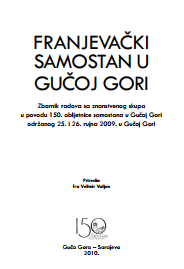Stećci gučogorskog kraja
Sanding tomb-stones in the Guča Gora region
Author(s): Marinko Slipac
Subject(s): History, Museology & Heritage Studies, Geography, Regional studies, Middle Ages
Published by: Franjevačka teologija Sarajevo
Keywords: middle ages; Lašva parish; Stećak; Guča Gora;
Summary/Abstract: Bosnian up-right tomb-stones are sepulchral gravestones renowned from the middle of the 12th to the end of the 15th century. The culmination form of trunk and roof-ridge was prominant in the times of the civil governor Stjepan Kontromanić (1322-1353), and especially in the times of Tvrtko I Kotromanić (1353-1391). Developmental growth ended in the form of the cross. “Lašva’s cross” is particular to the homonymous valley, and in fact it is a tombstone with a stressed head and undeveloped sides. Also “Lašva’s sarcophagus” is to be seen exclusively in the region of Lašva and characterized by ornamental motives and epitaphs with the original Bosnian lettering “bosanica”. During the Ottoman occupation the Catholics from this region inherited and preserved the continuity of middle-age tombstone construction in the form of Lašva’s cross. It was especiallz preserved in a diminished version, but preserved monuments are mostly from the 17th, 18th and 19th century.
Book: Franjevački samostan u Gučoj Gori
- Page Range: 491-535
- Page Count: 45
- Publication Year: 2010
- Language: Croatian
- Content File-PDF

